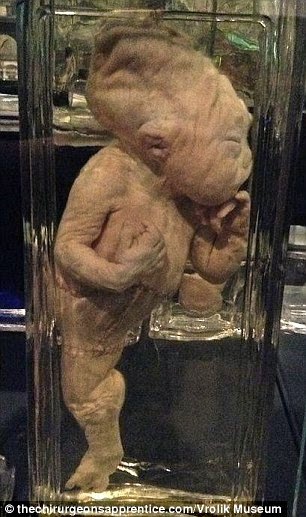For thousands of years they have occupied the world of fantasy, fairy tale and folklore.
The half-human, half-fish creatures first appeared in ancient Assyria, now Syria, when the goddess Atargatis transformed herself into a mermaid out of shame, having accidentally killed her human lover.
In history the seductive creatures have been linked to perilous events in European, African and Asian culture, including floods, storms, shipwrecks and drownings.
And they are associated with Greek mythology, Homer having referred to them as sirens - dangerous, yet beautiful creatures, who lured sailors to shipwreck.
Hans Christian Andersen's well-known fairy tale The Little Mermaid, was transformed into a Disney classic and mermaids have also been depicted in operas, paintings, books, films and comics.
But could the concept actually have been derived from a real medical condition?
Sirenomelia, also known as 'Mermaid syndrome' is a life-threatening illness, marked by the rotation and fusion of a sufferer's legs.
The rare congenital deformity causes what looks like a single limb, resembling a fish tail, in the womb.
Medical historian Lindsey Fitzharris, who has a PhD from Oxford University, told MailOnline the condition occurs from a failure of the normal vascular supply, when the umbilical cord fails to form two arteries.
As a result there is not sufficient blood supply reaching the foetus, she said.
The single artery 'steals' the blood and nutrition from the lower body, diverting it back up into the placenta.
Suffering malnutrition, the foetus fails to develop two separate limbs.
The condition is extremely rare, affecting one in 100,000 babies, but is 100 times more likely to occur in identical twins.
Babies born with the condition rarely live beyond a few days with more than half of cases resulting in stillbirth.
Dr Fitzharris, author of the blog The Chirurgeon's Apprentice, said: 'Over the course of my research, I've found very little about the disorder's history.
'There are snippets here and there which claim that foetuses born with sirenomelia were sometimes preserved in jars and put on display in 'freak shows' during the 19th century.
'But these sources are frustratingly vague.
'There is a brief mention of the condition in a four-volume atlas published in 1891 titled Human Monstrosities, but nothing that hints at how medical practitioners understood sirenomelia in earlier periods.
'Perhaps because the disorder is so rare, it's also been hard for me to locate specimens in anatomical collections.
'My search in the Hunterian Museum at the Royal College of Surgeons in London came up cold.
They stand in jars among more than 5,000 specimens of human and animal anatomy, embryology, pathology and congenital anomalies.
Dr Fitzharris added: 'Sirenomelia is extremely fatal.
'There are no accounts of anyone with this condition surviving in the past.
'Most died within days of being born due to kidney and bladder failure.
'Even today, the odds are against those with sirenomelia, though there are a handful of examples of children living past infancy.'
In 1988 Tiffany Yorks underwent surgery to separate her legs before her first birthday.
She still suffers some mobility problems, because of her fragile bones, and uses crutches and a wheelchair to get around.
At the age of 26, she is the oldest known surviving sufferer of the condition.
Another notable survivor of the rare disorder is a Peruvian girl, nicknamed the Little Mermaid.
In 2006 a team of eight specialists successfully carried out a second operation on the then two-year-old Milagros Cerron.
The youngster, whose first name means 'miracles' in Spanish, was born with the rare congenital disorder.
Her legs were fused from groin to ankles and her feet splayed, in the characteristic form of sirenomelia.
Most of Milagros's internal organs, including her heart and lungs, were in perfect condition.
But she was born with serious internal defects, including a deformed left kidney and a very small right kidney located very low in her body.
Her digestive, urinary tracts and genitals also shared a single tube.






No comments:
Post a Comment